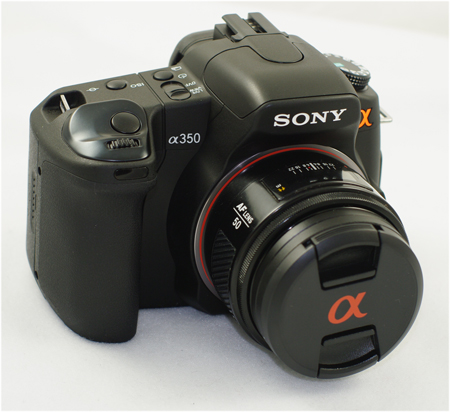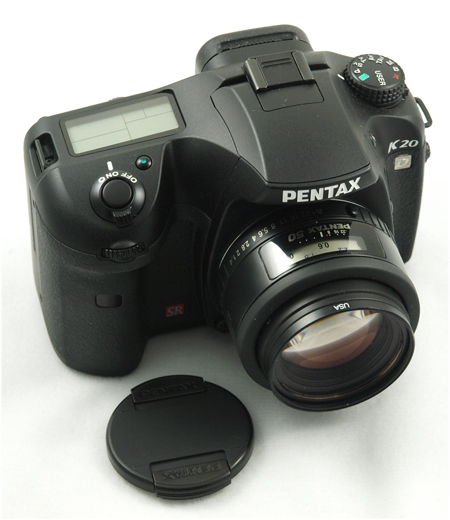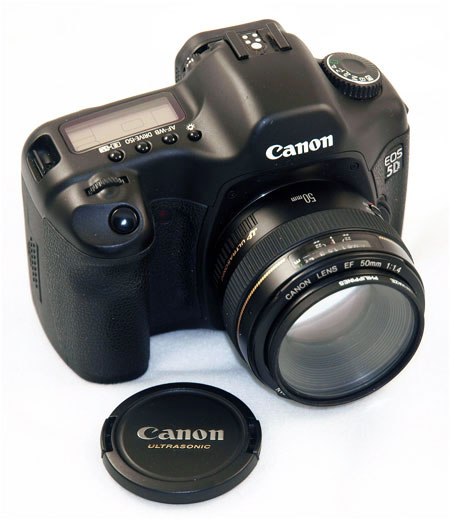Sony A350: Full-Time Live View at 14.2MP
by Wesley Fink on April 3, 2008 3:00 AM EST- Posted in
- Digital Camera
Resolution, Sensitivity and Image Quality
Sony likely wanted to scoop the industry with the 14.2MP resolution of the entry A350. That plan probably got scrapped by the 14.6MP Samsung CMOS sensor used in the prosumer Pentax K20D. While the A350 doesn't gain bragging rights as the highest res sensor south of $8000 it is still mighty close at 14.2MP. It is also the highest resolution sensor to be found in any current or announced entry-level DSLR.
Pentax went to great lengths to emphasize the greater size of their photoreceptor sites that made sensitivity more akin to the Sony/Nikon 12MP sensor. Pentax also emphasized the expanded sensitivity of their 14.6MP sensor with ISO options to 6400. Sony makes no special claims for the 14.2MP sensor in the A350, but the new sensor still has the option of ISOs to 3200.
We've already discussed how the A350 is easy to use with the best Live View you can find in a DSLR these days. The big remaining question, then, is whether the 14.2MP sensor really makes any difference in image quality.

To answer that question we considered that the most revealing test of sensitivity, noise, and resolution is low tungsten light typical of home interiors. The selected scene was not chosen to be pretty but to be revealing of sensitivity, noise, and image quality. It is a shot of my office stacked with motherboards and other review equipment taken with a standard 50mm f1.4 lens.

We found the APS-C 14.6MP CMOS sensor in the Pentax K20D to be excellent in sensitivity with well-controlled noise. The sensor size and resolution is roughly comparable to the A350, but the camera is much more expensive, uses a CMOS sensor rather than CCD, and it is targeted at the prosumer rather than entry-level. For those reasons, we included the Pentax K20D in these comparison tests.

The Canon 5D is justifiably famous for its incredible resolution with the full-frame 12.2MP CMOS sensor. The larger size sensor creates larger photo sites and the larger pixels are more sensitive to light than smaller APS-C sensors. The larger sensor size means the pixel size is more like an 8MP APS-C than a 12.2MP sensor. That makes for a good comparison to these two 14+MP sensors.
All images used a 50mm f1.4 lens (Pentax 50mm f1.4, Sony/Minolta 50mm f1.4, Canon Ultrasonic 50mm f1.4). Aperture Priority was used with a fixed aperture of f4 at all ISOs on all three cameras. Shots were taken using a tripod and remote shutter release to prevent shake. High ISO Noise Reduction used the lowest level of high ISO NR that could be selected in each camera. White Balance was manually set to Tungsten on each camera and the only light source is a 100W tungsten bulb. These harsh test conditions should make image noise as severe as you will likely see in each camera short of time-exposure darkness. Images were captured in JPEG format so they could be displayed and downloaded without the requirement for post-processing software.










113 Comments
View All Comments
Wesley Fink - Saturday, April 5, 2008 - link
Can you please post a link to the $30 price for the Sony NPFM500H battery? The battery for the new A700, A350, A300, and A200 is the same, but it is different from the earlier battery for the A100. The earlier A100 battery is both cheaper and available as a cheap generic, unlike the FM500H so far.I just checked and Amazon has a price of $54 with an "Out-of-Stock" for 1 to 2 months. Sony Style is $69.99. If it is now available for $30 ANYWHERE I'm sure a lot of Sony users would appreciate the link.
0roo0roo - Saturday, April 5, 2008 - link
typical sony arrogance. i would not give such a camera a second look because of the battery alone.Wesley Fink - Saturday, April 5, 2008 - link
The battery price was pretty annoying to a pot of posters on Forums and I thought it should definitely be discussed as most buyers don't discover this "gotcha" until after their purchase. As we mentioned, with Sony using the same expensive battery in all their new DSLRs there is some hope for a reasonably priced OEM battery in the future - unless Sony has something in the technology completely tied up with patents.Interestingly chargers for the old A100 battery work fine with the new FM500H. It appears the A100 batteries would work fine in the new cameras if they had the center groove that is on the FM500H. Perhaps some enterprising Asian source will come up with a battery at a decent price that will work in the new Sony cameras.
danddon - Friday, April 4, 2008 - link
I’m sorry, but I just couldn’t resist helping out Mr. Fink with his K20D technology – in particular, the 14.6 megapixel CMOS sensor.Just a few searches on the net uncovered the Pentax marketing material that describes this sensor, as well as a slide from an Asian presentation showing the structure and size of the individual photosites of the sensor.
Unfortunately, this material only proves that my method of calculation of photosite area was correct: the Pentax sensor has a photosite size of 5 microns, with an intersite gap of .13 microns. I said we should ignore this gap, because it is difficult to find the exact dimensions for all sensors in the literature.
I did not calculate the size of the photosites for the K20D sensor, but, for the sake of clarity and completeness:
23.4mm/4672 pixels = 5.009 microns
15.6mm/3104 pixels = 5.026 microns
Please note that this number should really be 5.13 microns, so my calculation is not 100 percent accurate. However, I felt it close enough for the purposes of this review. I will leave it to the reader to be the final judge.
What Mr. Fink was really referring to was the size of the photodiode at each photosite. The photodiode, as we all understand, is the device that actually does the conversion of the incoming photons to electrical energy. And, as we all understand, since it is not yet technically possible to construct a photodiode that covers the entire photosite, a microlens is placed over the top of the photosite assembly to focus the incoming photons onto the active area of the photodiode.
With good engineering, the combination of the structure of the microlens and the size of the photodiode, will result in an approximation of a photodiode that effectively covers the entire photosite. Of course, each manufacturer has their own techniques for optimizing this approximation, and probably much of the engineering could be considered a trade secret.
I tried to avoid all this complication by simply giving Mr. Fink the benefit of the doubt, and assuming in my calculation that the photodiode did, in fact, cover the entire photosite area. I thought this was in keeping with the tenor of the review itself, and subsequent discussions in this forum – keep it simple.
What Pentax claims to have achieved is a photodiode size that is larger than the photodiode size of the Sony A700 12.2 megapixel sensor. This size is measured as being 40 percent of the area of the photosite, which would be 40 percent of 25 or 10 sq. microns. I will give them and Mr. Fink that. However, this does not change the size of the photosite itself, which is: 5 microns.
Finally, Mr. Fink claims early in his response – “… the photosite size for the K20D does not scale as you indicate.”
I can only refer Mr. Fink to the folks at Samsung/Pentax, as well as to at least two other photography sources. These people would say that , in fact, yes - it does. And, I am constrained to point out – as my own calculation suggests.
But, I fear I have gone far, far astray from the original intent of the review, which was to simply look at the crops and determine the comparative noise attributes. Maybe I will try that sometime in the future, but don't hold your breath.
jake123 - Saturday, April 5, 2008 - link
Danddon, I doubt if you even knew the difference between a photodiode and photosite beforehand.But a clarification of terminology is a good thing.
Also, you should just compare the photos as Wesley tells you and judge for yourself.
danddon - Saturday, April 5, 2008 - link
Actually, Jake123, I didn't even know what a digital camera was until I happened upon the AnandTech site. But, I am trying to learn.I have used the instant film cameras on occasion, but only when I could sell enough cans and bottles from my shopping cart to pay for them.
Thank you for your helpful words of advice, and appreciate your patience. I will be comparing those photos as fast as my limited intelligence will allow.
I apologize if my feeble attempt at technology was not appreciated. I hope you weren't too offended.
Wesley Fink - Friday, April 4, 2008 - link
What is your point? The article does not mention photosite size except in passing. Did you really expect an in-depth treatise on the impact of photosite size in the front page discussion Forum of this review? There are many variables that affect the ability of a pixel to respond to light and the size of the pixel is one of them. It is important, but it is not the only variable, as you well know.The K20D and Canon 5D are CMOS sensors and the Sony A350 is CCD. I can point to articles at respected sites in the past who argued that CMOS sensors would always be inferior to CCD. Of course the entire Canon line is now CMOS, and all the new sensor introductions have been CMOS except this Sony 14.2 sensor. Even the A700/D300 is CMOS. Obviously manufacturers found ways to get around the inherent limitations of CMOS sensors. Photosite or pixel size is another inherent limitation.
The images are there for you to decide for yourself. If they aren't controlled enough for your liking you can perhaps find what you seek elsewhere on the web. Thank you for your research and for bringing your findings to my attention.
Barbu - Friday, April 4, 2008 - link
Last time I checked, being a PRO meant that you got your rent, your car and your equipment paid from the photography job. Mr. Fink might try to pose as a PRO, but no professional photographer would go on semi-auto mode in low-light. Really, that sentence looks like a high-school brag and for the real pros it's simply laughable.It's sad to see that the author ran out of valid reasoning and ended up using his fists to defend his... opera.
People, try to get this: even if the article is written in layman's terms, it has no practical value; mistakes over mistakes, and any beginner would make *different* mistakes or sub-optimal settings; the article is simply not relevant *for anybody*, enthusiast, prosumer, amateur or plain beginner.
_____________________________________________________
I'm almost certain of a thing: there would be no more polite replies, so I won't continue this thread. But (as many others will do) I'll have a very critical eye for WF's next articles, and any further error in dSLR testing will be sorely pointed out; the consequence will either be building mistrust in Anandtech (wich is a shame, considering the other very good articles), or -as an alternative- the author will be guided to other... workplace.
So, Mr. Fink: be very careful, you're watched.
Maxington - Saturday, April 5, 2008 - link
I've never seen a post more full of horrific levels of "YOU'RE NOT A PRO PHOTOGRAPHER" snobbery.Ken Rockwell is a pro photographer based on your criteria, and I'm not sure if he even knows how to take a photo in anything but full-auto, jpeg mode. And he reviews cameras!
Deadtrees - Saturday, April 5, 2008 - link
I agree Ken Rockwell doesn't know much yet reviews cameras. That's why he became a joke when it comes to camera reviews. Same mistake is being made right here on Anandtech.Not only that, Ken Rockwell is known for his huge ego. That, too, is quite same with the reviwer here on Anandtech.